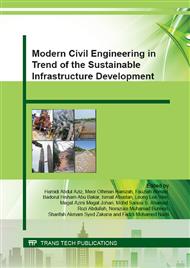p.249
p.255
p.261
p.267
p.272
p.277
p.283
p.290
p.295
Strength Development in Cement Admixed Fine-Grained Dredged Marine Soils
Abstract:
Dredged marine soils (DMS) are considered as wastes and are currently not being recycled. Solidification of DMS needs to be undertaken before the materials can be reused.This study focused on the development of strength of three solidified fine-grained DMS which are high plasticity clay (CH), high plasticity silt (MH) and low plasticity silt (ML) admixed with cement and bottom ash. This paper discussed the effect of water-binder ratio and curing period on the strength development of the solidified DMS. The results show that the strength increased with prolonged curing. The strength increased when the water-binder ratio was decreased. CH samples with water-binder (w/b) ratio =1 has the highest strength that are up to 4.7 MPa. Optimal w/b ratio for solidified DMS is w/b=3.
Info:
Periodical:
Pages:
272-276
Citation:
Online since:
October 2015
Authors:
Keywords:
Price:
Сopyright:
© 2015 Trans Tech Publications Ltd. All Rights Reserved
Share:
Citation:


